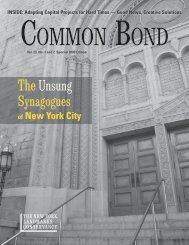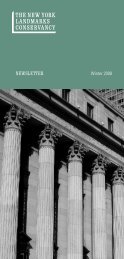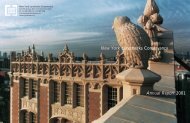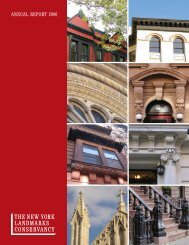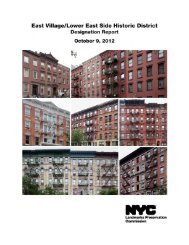Download Common Bond - The New York Landmarks Conservancy
Download Common Bond - The New York Landmarks Conservancy
Download Common Bond - The New York Landmarks Conservancy
Create successful ePaper yourself
Turn your PDF publications into a flip-book with our unique Google optimized e-Paper software.
Installation<br />
Perhaps surprisingly, lightning<br />
protection systems can be installed<br />
without detracting from the<br />
historic silhouette or the architectural<br />
features of a house of<br />
worship. Modern lightning rods<br />
are much less invasive than those of<br />
the past, and a professional<br />
installer can position conductors<br />
and cables in discreet locations to<br />
minimize their appearance.<br />
Permits may be required for<br />
lightning protection systems;<br />
congregations should contact local<br />
municipalities before beginning<br />
the installation process.<br />
Protecting structures from lightning<br />
destruction is a technical<br />
discipline. Professional installers<br />
should be accredited by Underwriters<br />
Laboratories (UL), which<br />
monitors installations through<br />
random spot checks. All equipment<br />
should bear UL labels as<br />
well. Installation companies can be<br />
found in the local yellow pages, by<br />
calling lightning protection trade<br />
organizations, or through referrals<br />
from other building owners.<br />
Congregations should make sure<br />
that installers are familiar with and<br />
follow the National Fire Protection<br />
Association’s standards for<br />
lightning protection systems.<br />
Installers should also carry<br />
adequate insurance and workman’s<br />
compensation. Recent referrals<br />
should be checked before hiring<br />
any installment company.<br />
Lightning protection<br />
systems can be<br />
installed without<br />
detracting from the<br />
architectural features<br />
of a house of worship<br />
When installing a new system, the<br />
installer will first survey the site<br />
and discuss the building’s needs<br />
(there may be a fee for this visit).<br />
Most installers will be able to<br />
design an appropriate system based<br />
on the building. <strong>The</strong>y should take<br />
care to protect the whole structure<br />
by placing rods at intervals along<br />
the entire roof line, not just at the<br />
tallest point. <strong>The</strong> installer should<br />
also make a plan to prevent damage<br />
to any historic building materials<br />
on the roof. For example, the<br />
installer will want to avoid nailing<br />
a rod directly into slate shingles,<br />
which may crack.<br />
If a congregation already has a<br />
lightning protection system, it may<br />
not be necessary to replace it, but it<br />
is a good idea to assess older<br />
systems periodically. A profes-<br />
<strong>Common</strong> <strong>Bond</strong> 8 Volume 16, No. 2/Winter 2001 ⏐ www.nylandmarks.org<br />
sional installer may be able to<br />
combine the older system with<br />
some new elements, without<br />
replacing all of the equipment.<br />
Before deciding whether to re-use<br />
portions of an existing system,<br />
congregations should consult a<br />
qualified professional to test the<br />
system elements for potential<br />
faults.<br />
Lightning protection systems are<br />
commonly installed during a repair<br />
or restoration project, or while a<br />
fire safety system is being installed.<br />
An architect or engineer overseeing<br />
the project can coordinate the<br />
installation. During construction<br />
projects on steeples and roofs,<br />
which can potentially disrupt rods<br />
or conductors, a professional<br />
installer can take precautions to<br />
ensure that the system is not<br />
compromised.<br />
It is recommended that the installer<br />
inspect the system every year. Some<br />
installers offer maintenance<br />
contracts. An annual system test is<br />
relatively inexpensive, frequently<br />
between $100 and $200, and is well<br />
worth the cost to ensure the<br />
protection of the historic structure.<br />
Often simple problems, such as<br />
broken connection between rods<br />
and conductors, can render a<br />
system useless. <strong>The</strong> installer can<br />
identify these problems with a<br />
simple resistance test. n



